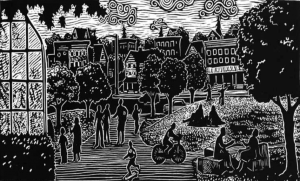Eric Klinenberg is an optimist. His book, Palaces for the People is dense with stories about communities that have managed to be resilient in times of stress and disaster. Klinenberg weaves occasionally complex background information together with narrative, explaining context and theories such as the histories of a demographic shift, spirals of disorder and decay, “Broken Windows” theory, and health statistics.
His sometimes informal tone makes the reading flow easily, yet at the end of the final chapter there are detailed notes and an index. Palaces for the People is written not only for the community-minded reader or social activist, but also for an array of professionals– sociologists, architects, urban designers, emergency planners and elected officials.

A city’s design is political
Klinenberg advocates for the revival of a flourishing civil life in America. His message is that well-designed public structures invite social connections that foster democracy, address inequalities, and help heal divisions across social divides. Even climate change disasters can be mitigated through design that takes civic life into consideration. The American Society of Civil Engineers has repeatedly assigned America’s overall infrastructure the grade of D+, most recently in 2017. For Klinenberg, this is a call to action; fixing the American physical infrastructure is an opportunity to simultaneously fix social infrastructure.
How does Klinenberg define “social infrastructure” his book’s theme? It’s “not social capital—a concept commonly used to measure people’s relationships and interpersonal networks—but the physical conditions that determine whether social capital develops; [it’s] public institutions such as libraries, schools, playgrounds, parks, athletic fields, and swimming pools… sidewalks, courtyards, community gardens, and other green spaces that invite people into the public realm.”
He includes private establishments like cafés, diners, barbershops, and bookstores. But, because commercial use can be exclusive and unaffordable, it ultimately falls upon the government, perhaps in collaboration with nonprofits or businesses, to take responsibility for providing social infrastructure.
Resisting the spread of anti-social infrastructure
Design Klinenberg finds the current administration “short sighted” and insular.” He calls the proposed border wall between Mexico and the US “quintessentially anti-social infrastructure.” He is similarly critical of gated communities, campus fraternities, and the gentrification of cities like San Francisco and Seattle by software companies that displace impoverished though middle-class citizenry. Facebook’s CEO Mark Zuckerberg, in particular, peeves Klinenberg because of his profit-driven and therefore flawed vision of a new form of democracy he imagines possible through social media.
Blighted urban neighborhoods and impoverished American cities without green spaces are the geographic focus of Klinenberg’s book. For example, he compares two demographically similar low-income, African-American communities in Chicago where extreme record temperatures killed 700+ people in 1995. Close connection saved lives: where residents knew their neighbors, far fewer died, simply because they checked on one another.
Libraries as places that preserve civility
Klinenberg reviews social infrastructure projects in other countries, as well. Icelandic “hot- pots,” geothermal pools built by the government throughout Iceland (where class tensions ran high after massive bank failures in 2008) are heavily used by all ages and classes. Hot-pots facilitate relaxed community conversation and even civic meetings. The universal rule that everyone must strip naked in a public area before entering makes the experience a social equalizer.
Libraries are Klinenberg’s premier example of a critical and undervalued form of social infrastructure. They provide the perfect setting for inclusive social interaction. He loves librarians as committed, nonjudgmental public servants. Libraries and librarians provide dignity and refuge while promoting tolerance and equality. Both buffer social problems including loneliness, isolation, and illiteracy. He also admires the “robber-baron” Andrew Carnegie, for his philanthropy — despite his infamous violent suppression of railroad-union workers. Carnegie built 2800 palatial libraries in the early twentieth century for “boys and girls who have good within them and ability and ambition to develop it.” Klinenberg wonders why so few of the modern ultra-wealthy information technology moguls have not supported libraries. He suggests that libraries need defending because philanthropists are not forthcoming and their funding is under siege.
Close to home, three Timberline Regional Library branches could close next year based on budget deficit projections. Tenino, Montesano, and Hoquiam—where the town has completed a million dollar renovation to its historic Carnegie Library–could close. Citizens at the September TRL budget meeting were upset. None supported these closures. One woman called her Tenino library “the center of the town,” and said that “rural people need it and appreciate it, get value out of it.”
The TRL Board was moved to reconsider, but they say the system will be $700,000 in the hole next year without cuts. Klinenberg would not be surprised hear this. To him libraries are sacred institutions which politicians don’t like to defend, instead looking to replace them with new technologies without realizing what would be lost. For example Timberland has floated the idea of “library trucks” as one element of a solution to the financial problem. I think Klineberg would encourage TRL users to come together at local libraries to strategize for fund-raising and protection of the critical social infrastructure that libraries provide.
Palaces for the People: How Social Infrastructure Can Help Fight Inequality, Polarization and the Decline of Civic Life (Crown, 2018) by Eric Klinenberg
Kathy Harrigan grew up in Seattle and lives in Olympia. She has taught courses including adult education, English and theater; special ed and GED/ESL/literacy in highschools, community colleges and jails. She has supervised and designed programs for community centers. She holds a BA in Education from the UW and an MA in Humanities from Cal State, Dominguez Hills.